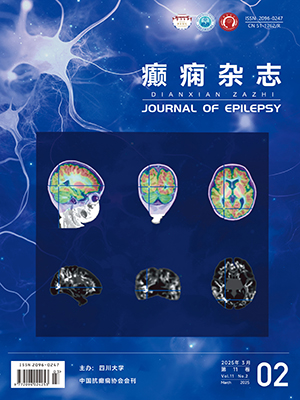| 1. |
中国抗癫痫协会. 临床诊疗指南: 癫痫病分册. 人民卫生出版社, 2023.
|
| 2. |
Beghi E. Addressing the burden of epilepsy: many unmet needs. Pharmacol Res, 2016, 107: 79-84.
|
| 3. |
Ma XP, Li YP, Yang R, et al. Challenges of patients with epilepsy and measures for improving epilepsy care in western China: a qualitative study. Epilepsy Res, 2021, 178: 106788.
|
| 4. |
Wang WZ, Wu JZ, Wang DS, et al. The prevalence and treatment gap in epilepsy in China: an ILAE/IBE/WHO study. Neurology, 2003, 60(9): 1544-1545.
|
| 5. |
Peterson GM, Naunton M. Valproate: a simple chemical with so much to offer. J Clin Pharm Ther, 2005, 30(5): 417-421.
|
| 6. |
Tomson T, Battino D, Perucca E. Valproic acid after five decades of use in epilepsy: time to reconsider the indications of a time-honoured drug. Lancet Neurol, 2016, 15(2): 210-218.
|
| 7. |
Singh D, Gupta S, Verma I, et al. Hidden pharmacological activities of valproic acid: a new insight. Biomed Pharmacother, 2021, 142: 112021.
|
| 8. |
Kwan P, Brodie MJ. Early identification of refractory epilepsy. N Engl J Med, 2000, 342(5): 314-319.
|
| 9. |
Nickels K, Kossoff EH, Eschbach K, et al. Epilepsy with myoclonic-atonic seizures (Doose syndrome): clarification of diagnosis and treatment options through a large retrospective multicenter cohort. Epilepsia, 2021, 62(1): 120-127.
|
| 10. |
Kanner AM, Bicchi MM. Antiseizure medications for adults with epilepsy: a review. JAMA, 2022, 327(13): 1269-1281.
|
| 11. |
Keezer MR, Sisodiya SM, Sander JW. Comorbidities of epilepsy: current concepts and future perspectives. Lancet Neurol, 2016, 15(1): 106-115.
|
| 12. |
Stevenson SB. Epilepsy and migraine headache: is there a connection? J Pediatr Health Care, 2006, 20(3): 167-171.
|
| 13. |
Haut SR, Bigal ME, Lipton RB. Chronic disorders with episodic manifestations: focus on epilepsy and migraine. Lancet Neurol, 2006, 5(2): 148-157.
|
| 14. |
Chen B, Choi H, Hirsch LJ, et al. Psychiatric and behavioral side effects of antiepileptic drugs in adults with epilepsy. Epilepsy Behav, 2017, 76: 24-31.
|
| 15. |
Villanueva V, Artal J, Cabeza-Alvarez CI, et al. Proposed recommendations for the management of depression in adults with epilepsy: an expert consensus. Neurol Ther, 2023, 12(2): 479-503.
|
| 16. |
Munger Clary HM. Anxiety and epilepsy: what neurologists and epileptologists should know. Curr Neurol Neurosci Rep, 2014, 14(5): 445.
|
| 17. |
Kanemura H, Sano F, Tando T, et al. EEG improvements with antiepileptic drug treatment can show a high correlation with behavioral recovery in children with ADHD. Epilepsy Behav, 2013, 27(3): 443-448.
|
| 18. |
Schubert R. Attention deficit disorder and epilepsy. Pediatr Neurol, 2005, 32(1): 1-10.
|
| 19. |
Han SA, Yang EJ, Song MK, et al. Effects of lamotrigine on attention-deficit hyperactivity disorder in pediatric epilepsy patients. Korean J Pediatr, 2017, 60(6): 189-195.
|
| 20. |
Gul A, Mehreen S. Effectiveness of Lacosamide on everyday cognitive deficits, psychiatric symptoms and resilience in patients with epilepsy. J Pak Med Assoc, 2020, 70(9): 1611-1615.
|
| 21. |
Liang S, Fan X, Chen F, et al. Chinese guideline on the application of anti-seizure medications in the perioperative period of supratentorial craniocerebral surgery. Ther Adv Neurol Disord, 2022, 15: 17562864221114357.
|
| 22. |
Wu M, Hao N, Yan B, et al. Status epilepticus in pregnant women with epilepsy after valproate adjustment: A case series. Seizure, 2016, 43: 39-41.
|
| 23. |
Tomson T, Marson A, Boon P, et al. Valproate in the treatment of epilepsy in girls and women of childbearing potential. Epilepsia, 2015, 56(7): 1006-1019.
|
| 24. |
Bardai A, Blom MT, van Noord C, et al. Sudden cardiac death is associated both with epilepsy and with use of antiepileptic medications. Heart, 2015, 101(1): 17-22.
|
| 25. |
Yang CY, Dao RL, Lee TJ, et al. Severe cutaneous adverse reactions to antiepileptic drugs in Asians. Neurology, 2011, 77(23): 2025-2033.
|
| 26. |
Shukla S, Rastogi S, Abdi SAH, et al. Severe cutaneous adverse reactions in Asians: Trends observed in culprit anti-seizure medicines using VigiBase(R). Seizure, 2021, 91: 332-338.
|
| 27. |
Chen WB, Gao R, Su YY, et al. Valproate versus diazepam for generalized convulsive status epilepticus: a pilot study. Eur J Neurol, 2011, 18(12): 1391-1396.
|
| 28. |
Lee SA, Lee JK, Heo K. Coma probably induced by lorazepam-valproate interaction. Seizure, 2002, 11(2): 124-125.
|
| 29. |
Morris RG, Black AB, Lam E, et al. Clinical study of lamotrigine and valproic acid in patients with epilepsy: using a drug interaction to advantage? Ther Drug Monit, 2000, 22(6): 656-660.
|
| 30. |
Al-Quteimat O, Laila A. Valproate Interaction With Carbapenems: Review and Recommendations. Hosp Pharm, 2020, 55(3): 181-187.
|
| 31. |
Albanji M, Alshehri S, Eljaaly K. The effect of erythromycin and clarithromycin versus azithromycin on serum valproate concentration. Saudi Pharm J, 2022, 30(4): 337-339.
|
| 32. |
Zhou C, Sui Y, Zhao W, et al. The critical interaction between valproate sodium and warfarin: case report and review. BMC Pharmacol Toxicol, 2018, 19(1): 60.
|




